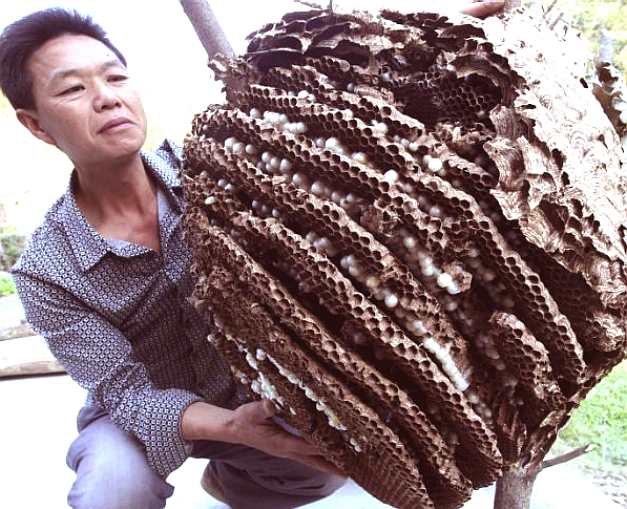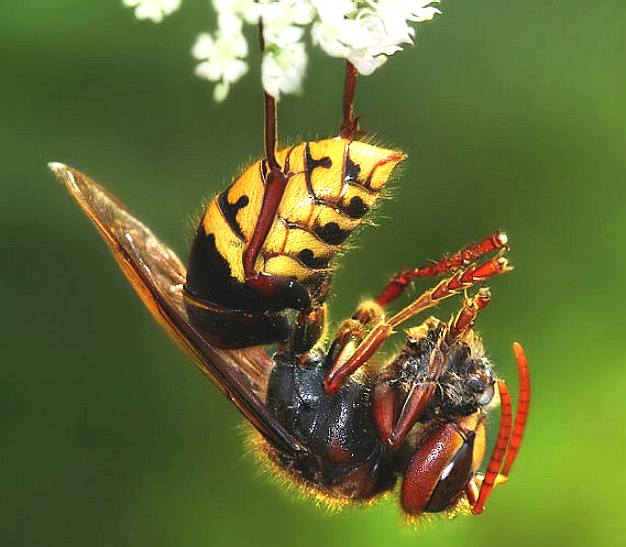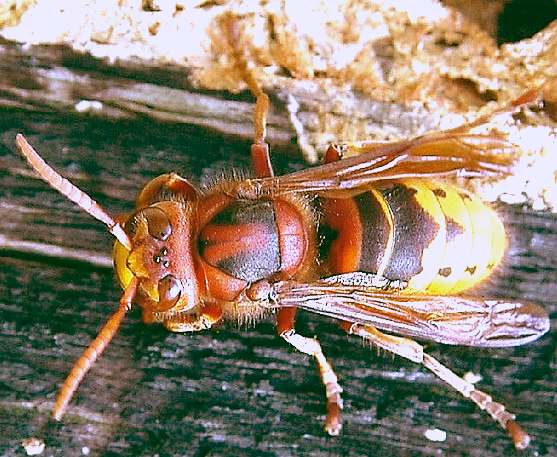
OCTOBER
8 2013 CHINA
Chinese officials are fighting back against giant hornets which have killed 42 people and left 1,600 injured.
In China's northern Shaanxi province, whole cities have been terrorised by the world's largest hornet which has started attacking people.
Now government officials have started fighting fire with fire - literally - by burning and gassing the thumb-sized bugs out of their hives.
Workers wearing protective clothing have moved in to eradicate the nightmare insects before any more people are injured.
Horrific pictures have emerged of wounds the size of bullet holes left in the arms of victims after being stung.
Over the past three months the cities of Angkang, Hanzhong and Shangluo have been worst affected.
One victim told local media that 'the more you run, the more they want to chase you' and some victims described being chased about 200 metres (656 feet) by the deadly insects.
Authorities have mobilised a special medic team and trained more medical personnel to treat victims.
The insects' highly toxic stings can lead to anaphylactic shock and renal failure.
One of the victims, named only as Mu, said she has spent two months in a hospital undergoing 13 dialysis treatments.
She has 200 stitches, but still cannot move her legs. She told Xinhua, the Chinese state-run news agency: 'The hornets were horrifying'.
'They hit right at my head and covered my legs. All of a sudden I was stung and I couldn't move.
'Even now, my legs are covered with sting holes.'
Attacks on humans are rare and specialists are unable to fully explain why this year has seen so many more cases.
Theories include increased plant growth boosting the number of the insects, and unusually warm weather making the creatures more agitated.
September and October is the breeding season for the big bugs, meaning now is when they are most active.
The insects are an aggressive and predatory animal, however, and will send out scouts to look for honeybee hives for them to
colonise.
When one is found the scout will leave a pheromone trail which other hornets will then follow, before using their jaws to decapitate the bees.
After slaughtering thousands of the much smaller creatures, the hornets will then take over the nest for themselves.
The species has already spread to France and fears are growing that giant Asian hornets are headed for Britain.
The species is four times the size of our native honeybees which are already struggling due to a mysterious syndrome which wipes out entire nests.
The dark invaders with yellow feet are thought to have arrive in France in a delivery of Chinese pottery from the Far East in late 2004.
The insects have colonised huge swathes of
France, spreading along waterways, and with a few hornets capable of destroying 30,000 bees in a couple of hours, honey production has plummeted.
It has so far colonised 39 of France’s 100 administrative departments.

UK
PERSONAL EXPERIENCE
I
once caught a hornet building a nest in a new loft I'd built from
softwood. At first I took great care not to get too close, because of the
fearsome reputation of the insect. And it was a whopper, close on 4.5
centimeters. But, I could not just let it eat my new timbers, and create a
high risk area right on my doorstep. So, I crept up to the busy chappie
(actually a lass) with a large glass jar, into which the rather slow
hornet tumbled - and bang went the lid. It was my prisoner.
Strangely,
I started feeling sorry for it. I gave it some honey and jam, and some
water. I put a lot of brown paper into the jar and made sure to interact
at least once a day. But the poor thing was dead within a week. I was
devastated. I knew she'd died of loneliness, or that and a mixture of
hopelessness. I'll never imprison a flying insect again - and I've been
stung many times by angry wasps - that I'd only kill if there was
absolutely no way we could co-exist. It is cruel to keep a winged animal
captive. Either put the insect out of its misery or let it go.
DESCRIPTION
Hornets are the largest eusocial wasps; some species can reach up to 5.5 cm (2.2 in) in length. The true hornets make up the genus Vespa and are distinguished from other vespines by the width of the vertex (part of the head behind the eyes), which is proportionally larger in Vespa and by the anteriorly rounded gasters (the section of the abdomen behind the
wasp waist). The best known species is the European hornet (Vespa crabro), about 2–3.5 cm in length, widely distributed throughout
Europe, Russia, North America and Northeast Asia.
LIFE CYCLE
In Vespa crabro, the nest is founded in spring by a fertilized female known as the queen. She generally selects sheltered places like dark hollow tree trunks. She first builds a series of cells (up to 50) out of chewed tree bark. The cells are arranged in horizontal layers named combs, each cell being vertical and closed at the top. An egg is then laid in each cell. After 5–8 days, the egg hatches, and in the next two weeks, the larva undergoes its five stages. During this time, the queen feeds it a protein-rich diet of insects. Then, the larva spins a silk cap over the cell's opening and, during the next two weeks, transforms into an adult, a process called metamorphosis. The adult then eats its way through the silk cap. This first generation of workers, invariably females, will now gradually undertake all the tasks formerly carried out by the queen (foraging, nest building, taking care of the brood, etc.) with one exception: egg-laying, which remains exclusive to the queen.
As the colony size grows, new combs are added, and an envelope is built around the cell layers until the nest is entirely covered with the exception of an entry hole. At the peak of its population, the colony can reach a size of 700 workers, which occurs in late summer.
At this time, the queen starts producing the first reproductive individuals. Fertilized eggs develop into females (called "gynes" by entomologists), and unfertilized ones develop into males (sometimes called "drones"). Adult males do not participate in nest maintenance, foraging, or caretaking of the larvae. In early to mid autumn, they leave the nest and mate during "nuptial flights". Males die shortly after mating. The workers and queens survive at most until mid to late autumn; only the fertilized queens survive over winter.
Other temperate species (e.g. the yellow hornet, V. simillima, or the Oriental hornet, V. orientalis) have similar cycles. In the case of tropical species (e.g., V. tropica), life histories may well differ, and in species with both tropical and temperate distributions (such as the Asian giant hornet, Vespa mandarinia), it is conceivable that the cycle depends on latitude.

DISTRIBUTION
Hornets are found mainly in the Northern Hemisphere. The common European hornet, also called Vespa crabro, is the better known species, widely distributed in Europe (but is never found north of the 63rd parallel), in North China and also the only species introduced to North America, Ukraine and European Russia (except in extreme northern areas). In the east, the species' distribution area stretches over the Ural Mountains to Western Siberia (found in the vicinity of Khanty-Mansiysk). The common European hornet was accidentally introduced to North America about the middle of the 19th century, and has lived there since at about the same latitudes as in Europe. However, it has never been found in western North America. In Asia, the common European hornet is found in southern Siberia, as well as in eastern China.
The Asian giant hornet (Vespa mandarinia) lives in the Primorsky Krai region of Russia, China, Korea, Taiwan, Cambodia, Laos, Vietnam, Indochina, India, Nepal, Sri Lanka, Thailand, but is most commonly found in the mountains of Japan, where they are commonly known as the Giant Sparrow Bee.
The Oriental hornet occurs in semi-dry sub-tropical areas of Central Asia
(Iran, Turkey, Afghanistan, Oman,
Pakistan, Turkmenistan, Uzbekistan, Tajikistan), southern Europe (Italy, Malta, Albania, Romania, Greece, Bulgaria, Cyprus), North Africa (Algeria, Libya, Egypt, Sudan, Eritrea, Somalia), and along the shores of the Gulf of Aden and in the Middle East. It has been introduced to Madagascar.
The Asian predatory wasp, Vespa velutina has been introduced to France and Spain.
STINGS
Hornets have stings used to kill prey and defend hives. Hornet stings are more painful to humans than typical wasp stings because hornet venom contains a large amount (5%) of acetylcholine. Individual hornets can sting multiple times; unlike typical bees, hornets and wasps do not die after stinging because their stingers are not barbed and are not pulled out of their bodies.
The toxicity of hornet stings varies according to hornet species; some deliver just a typical insect sting, while others are among the most venomous known insects. Single hornet stings are not in themselves fatal, except sometimes to allergic victims.
Multiple stings by non-European hornets may be fatal because of highly toxic species-specific components of their venom.
The stings of the Asian giant hornet (Vespa mandarinia japonica) are the most venomous known, and are thought to cause 30-50 human deaths annually in
Japan and 42 in China in July-September 2013 alone. Non-queens being 1.4-1.5 inches in length, the Asian giant hornet's venom can cause allergic reactions and multiple organ failure leading to death, though dialysis can be used to remove the toxins from the bloodstream.
People who are allergic to wasp venom are also allergic to hornet stings. Allergic reactions are commonly treated with epinephrine (adrenaline) injection using a device such as an epinephrine autoinjector, with prompt follow-up treatment in a hospital. In severe cases, allergic individuals may go into anaphylactic shock and die unless treated promptly.

ATTACK PHEROMONE
Hornets, like many social wasps, can mobilize the entire nest to sting in defense, which is highly dangerous to animals and
humans. The attack pheromone is released in case of threat to the nest. In the case of the Asian giant hornet, Vespa mandarina, this is also used to mobilize many workers at once when attacking colonies of their prey, honey bees. Three biologically active chemicals, 2-pentanol, 3-methyl-1-butanol, and 1-methylbutyl 3-methylbutanoate, have been identified for this species. In field tests, 2-pentanol alone triggered mild alarm and defensive behavior, but adding the other two compounds increased aggressiveness in a synergistic effect. In the European hornet, Vespa crabro, the major compound of the alarm pheromone is 2-methyl-3-butene-2-ol.
If a hornet is killed near a nest it may release pheromone which can cause the other hornets to attack. Materials that come in contact with pheromone, such as clothes, skin, and dead prey or hornets, can also trigger an attack, as can certain food flavorings, such as banana and apple flavorings, and fragrances which contain C5 alcohols and C10 esters.
PREY
Adult hornets and their relatives (e.g., yellowjackets) feed themselves on nectar and sugar-rich plant foods. Thus, they can often be seen on the sap of oak trees, rotting sweet fruits, honey and any sugar-containing foodstuffs. Hornets frequently fly into orchards to feast on over-ripe fruit. Hornets tend to gnaw a hole into fruit to be totally immersed in its meat. A person who accidentally plucks a fruit with a feeding hornet can be attacked by the disturbed insect.
The adults prey on various insects as well, which they kill with stings and jaws. Due to their size and the power of venom, hornets are able to kill large insects such as honey bees, grasshoppers, locusts and mantises without difficulty or much effort. The victim is fully masticated and then fed down in the form of slurry to the larvae developing in the nest, rather than consumed by the adult hornets. Given that some of their prey are considered pests, hornets may be considered beneficial under some circumstances.
OTHER VESPIDAE
While taxonomically well-defined, there may be some confusion about the differences between hornets and other wasps of the family Vespidae, specifically the yellowjackets, which are members of the same subfamily. Yellowjackets are generally smaller than hornets and are bright yellow and black, whereas hornets may often be black and white.
Some other large wasps are sometimes referred to as hornets, most notably the bald-faced hornet (Dolichovespula maculata) found in
North
America. It is set apart by its black and ivory coloration. The name "hornet" is used for this and related species primarily because of their habit of making aerial nests (similar to the true hornets) rather than subterranean nests. Another example is the
Australian hornet (Abispa ephippium), which is actually a species of potter wasp.





